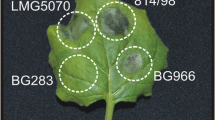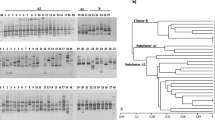Abstract
The paper deals with a comparative analysis of the serological and ecological properties of Pseudomonas syringae pv. atrofaciens strains from the collections of microbial cultures at the Malkov Institute for Plant Genetic Resources and Zabolotny Institute of Microbiology and Virology. All of the strains from the Bulgarian collection, except for one, fall into five serogroups (II through VI) of the classification system of Pastushenko and Simonovich. The P. syringae pv. atrofaciens strains isolated from Bulgarian and Ukrainian wheats belong mainly to serogroups II and IV, respectively. The strains that were isolated from rye plants belong to serogroup I. The strains isolated from sorghum and Sudan grass belong to serogroups II, IV, and VI. Serogroup III includes the P. syringae pv. atrofaciens strains that were isolated from cereals in the United Kingdom but not in Ukraine.
Similar content being viewed by others
REFERENCES
Al-Sallami, F., Karov, S.P., Vassileva, P., Popova, R., and Vassilev, V., Pseudomonas syringae pv. atrofaciens Associated with Fungal Black Point of Wheat (Triticum aestivum) Grain, Dev. Plant Pathol., 1997, vol. 9, pp. 505-509.
Bazzi, C., Stead, D.E., Alexandrova, M., and Stefani, E., Identification and Classification of Fluorescent Pseudomonas Species from Cereals in Italy, Dev. Plant Pathol., 1997, vol. 9, pp. 509-514.
Toben, H., Mavridis, A., and Rudolf, K., Occurrence of Basal Glume Rot (Pseudomonas syringae pv. atrofaciens) on Cereals in West Germany and Testing for Resistance in Wheat, Plant Pathogenic Bacteria, Proceedings 7th Int. Conf., Budapest, 1990, pp. 643-648.
Von Kietzel, J. and Rudolph, K., Epiphytic Occurrence and Spread of Pseudomonas syringae pv. atrofaciens, Dev. Plant Pathol., 1997, vol. 9, pp. 29-34.
Pastushenko, L.T. Koroleva, I.B., Sidorenko, S.S., and Simonovich, I.D., Serological Study of the Pathogen of Basal Bacteriosis in Wheat, Sel'skokhoz. Biol., 1976, vol. 11,no. 4, pp. 582-586.
Pastushenko, L.T. and Simonovich, I.D., Serologic Groups of Phytopathogenic Bacteria of the Pseudomonas Genus: II. Antigenic Affinity of Different Species, Mikrobiol. Zh., 1979, vol. 41,no. 4, pp. 330-339.
Pasichnik, L.A., Koroleva, I.B., and Gvozdyak, R.I., Serological Properties of Rye Bacteriosis Agent Pseudomonas syringae pv. atrofaciens, Mikrobiol. Zh., 1991, vol. 53,no. 6, pp. 82-87.
Methods in Phytobacteriology, Klement, Z. et al., Eds., Budapest: Akademiai Kiado, 1990.
Pastushenko, L.T. and Simonovich, I.D., Obtaining of Specific Sera to Phytopathogenic Bacteria of the Genus Pseudomonas, Mikrobiol. Zh., 1971, vol. 33,no. 1, pp. 37-40.
Pastushenko, L.T. and Simonovich, I.D., Study of Methods for Obtaining Antigens of the Pathogenic Bacteria of the Genus Pseudomonas, Mikrobiol. Zh., 1971, vol. 33,no. 3, pp. 289-295.
Otta, J.D. and English, H., Serology and Pathology of Pseudomonas syringae, Phytopathology, 1971, 61,no. 5, pp. 443-452.
Otta, J.D., Occurrence and Characteristics of Isolates of Pseudomonas syringae on Winter Wheat, Phytopathology, 1977, vol. 67,no. 1, pp. 22-26.
Yakovleva, L.M., The Serological Properties of Bacteria from the Genus Pseudomonas Pathogenic to Poplar, Fitopatogennye bakterii (Phytopathogenic Bacteria), Kiev: Nauk. Dumka, 1975, pp. 66-71.
Zdorovenko, G., Knirel, Yu., Gvozdyak, R., and Yakovleva, L., Structural Features and Biological Activities of the Pseudomonas syringae Lipopolysaccharides, Proc. Int. Regional Seminar “Environment Protection: Modern Studies in Ecology and Microbiology,” Uzhgorod, 1997, vol. 2, pp. 187-191.
Knirel, Y.A., Ovod, V., Zdorovenko, G.M., Gvozdyak, R.I., and Krohn, K.J., Structure of the O-Polysaccharide and Immunochemical Relationships between the Lipopolysaccharides of Pseudomonas syringae Pathovars tomato and maculicola, Eur. J. Biochem., 1998, vol. 258, pp. 657-661.
Knirel, Y.A., and Zdorovenko, G.M., Structures of the O-Polysaccharide Chains of Lipopolysaccharides as the Basis for Classification of Pseudomonas syringae and Related Strains, Dev. Plant Pathol., 1997, vol. 9, pp. 475-480.
Ovod, V., Yakovleva, L.M., and Krohn, K., Classification of Pseudomonas syringae with Monoclonal Antibodies against the Core and O-Side Chain of the Lipopolysaccharide, Phytopathology, 1995, vol. 85,no. 2, pp. 226-232.
Zdorovenko, G.M., Yakovleva, L.M., and Veremeichenko, S.N., Studies on the O-Antigen Epitopes in the Lipopolysaccharides of Pseudomonas strains, Abstracts of the 11th European Carbohydrate Symposium, Lisboa, Portugal, September 2–7, 2001, p. 400.
Saunier, M., Malandrin, L., and Samson, R., Distribution of Pseudomonas syringae Pathovars into Twenty-Three O Serogroups, Appl. Environ. Microbiol., 1996, vol. 62,no. 7, pp. 2360-2374.
Pasichnik, L.A., Antigenic Properties of Pathovars of Bacteria of Pseudomonas syringae Affecting Cereals, Mikrobiol. Zh., 2000, vol. 62,no. 5, pp. 18-22.
Author information
Authors and Affiliations
Rights and permissions
About this article
Cite this article
Pasichnik, L.A., Yakovleva, L.M., Gvozdyak, R.I. et al. The Serological Heterogeneity of Pseudomonas syringae pv. atrofaciens Strains and Their Ecological Niches. Microbiology 72, 733–737 (2003). https://doi.org/10.1023/B:MICI.0000008377.53112.ae
Issue Date:
DOI: https://doi.org/10.1023/B:MICI.0000008377.53112.ae




